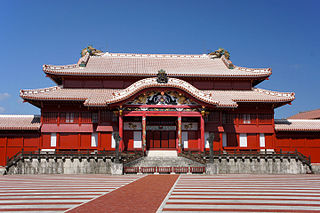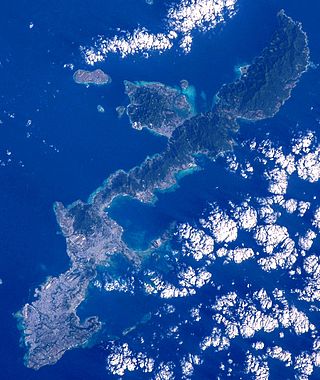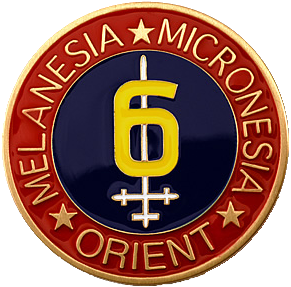Biography
Alvin Ley was born in Hewitt, Wood County, Wisconsin United States and was ordained to the Roman Catholic priesthood on June 14, 1936.
Father Ley was sent to Guam, where he was taken prisoner by the Japanese army during World War II. [3] He was held prisoner of war at Kobe, Japan. After World War II, he was sent to Okinawa.
On March 11, 1968, Pope Paul VI appointed Felix Ley the apostolic administrator of the Okinawa and the Southern Islands/Ryukyus, and he was consecrated bishop on June 9, 1968. [4]
Bishop Ley died in Naha. [5]

Okinawa Prefecture is the southernmost and westernmost prefecture of Japan. It has a population of 1,457,162 and a geographic area of 2,281 km2.

This article is about the history of the Ryukyu Islands, located southwest of the main islands of Japan.

The Ryukyu Kingdom was a kingdom in the Ryukyu Islands from 1429 to 1879. It was ruled as a tributary state of imperial Ming China by the Ryukyuan monarchy, who unified Okinawa Island to end the Sanzan period, and extended the kingdom to the Amami Islands and Sakishima Islands. The Ryukyu Kingdom played a central role in the maritime trade networks of medieval East Asia and Southeast Asia despite its small size. The Ryukyu Kingdom became a vassal state of the Satsuma Domain of Japan after the invasion of Ryukyu in 1609 but retained de jure independence until it was transformed into the Ryukyu Domain by the Empire of Japan in 1872. The Ryukyu Kingdom was formally annexed and dissolved by Japan in 1879 to form Okinawa Prefecture, and the Ryukyuan monarchy was integrated into the new Japanese nobility.

Okinawa Island, officially Okinawa Main Island, is the largest of the Okinawa Islands and the Ryukyu (Nansei) Islands of Japan in the Kyushu region. It is the smallest and least populated of the five main islands of Japan. The island is approximately 106 kilometres (66 mi) long, an average 11 kilometres (7 mi) wide, and has an area of 1,206.98 square kilometers (466.02 sq mi). It is roughly 640 kilometres south of the main island of Kyushu and the rest of Japan. It is 500 km northeast of Taiwan. The total population of Okinawa Island is 1,384,762. The greater Naha area has roughly 800,000 residents, while the city itself has about 320,000 people. Naha is the seat of Okinawa Prefecture on the southwestern part of Okinawa Island. Okinawa has a humid subtropical climate.
An apostolic administration in the Catholic Church is administrated by a prelate appointed by the pope to serve as the ordinary for a specific area. Either the area is not yet a diocese, or is a diocese, archdiocese, eparchy or similar permanent ordinariate that either has no bishop or archbishop or, in very rare cases, has an incapacitated (arch)bishop. The title also applies to an outgoing (arch)bishop while awaiting for the date of assuming his new position.

The 6th Marine Division was a United States Marine Corps World War II infantry division formed in September 1944. During the invasion of Okinawa it saw combat at Yae-Take and Sugar Loaf Hill and was awarded a Presidential Unit Citation. The 6th Division had also prepared for the invasion of Japan before the war ended. After the war it served in Tsingtao, China, where the division was disbanded on April 1, 1946, being the only Marine division to be formed and disbanded overseas and never set foot in the United States.

Kadena Air Base is a United States Air Force base in the towns of Kadena and Chatan and the city of Okinawa, in Okinawa Prefecture, Japan. It is often referred to as the "Keystone of the Pacific" because of its highly strategic location. It is located 650 km (400 mi) off the coast of China and at a distance of 770 km (480 mi) from Shanghai, a major Chinese economic hub. It is home to the USAF's 18th Wing, the 353rd Special Operations Wing, reconnaissance units, 1st Battalion, 1st Air Defense Artillery Regiment, and a variety of associated units. Over 20,000 American servicemembers, family members, and Japanese employees live or work at Kadena Air Base. It is the largest and most active U.S. Air Force base in East Asia.
National Route 58 is a Japanese national highway connecting the capital cities Kagoshima and Naha of Kagoshima Prefecture and Okinawa Prefecture, respectively. With a total length of 884.4 kilometers (549.5 mi), it is the longest national highway in Japan, though it measures only 245.2 kilometers (152.4 mi) on land. The highway begins at an intersection with National Routes 3 and 10 in Kagoshima. From Kagoshima, it travels southwest along the first island chain that divides the Pacific Ocean from the East China Sea. From the north to the south, it has sections on the islands of Tanegashima, Amami Ōshima, and finally, Okinawa. On Okinawa it ends at an intersection with National Routes 330, 331, and 390 in Naha.

The United States Civil Administration of the Ryukyu Islands abbr. USCAR was the civil administration government in the Ryukyu Islands, Japan, replacing the United States Military Government of the Ryukyu Islands in 1950, and functioned until the islands were returned to Japan in 1972. It oversaw the native Ryukyuan Government. It could overrule all the decisions made by the native government.

Naha is the capital city of Okinawa Prefecture, the southernmost prefecture of Japan. As of 1 June 2019, the city has an estimated population of 317,405 and a population density of 7,939 people per km2. The total area is 39.98 km2 (15.44 sq mi).

Shuri is a district of the city of Naha, Okinawa, Japan. Formerly a separate city in and of itself, it was once the royal capital of the Ryūkyū Kingdom, hence the name. A number of famous historical sites are located in Shuri, including Shuri Castle, the Shureimon gate, Sunuhyan-utaki, and royal mausoleum Tamaudun, all of which are designated World Heritage Sites by UNESCO.

The Ryukyu Islands, also known as the Nansei Islands or the Ryukyu Arc, are a chain of Japanese islands that stretch southwest from Kyushu to Taiwan: the Ryukyu Islands are divided into the Satsunan Islands and Okinawa Prefecture. The larger ones are mostly volcanic islands and the smaller mostly coral. The largest is Okinawa Island.

USS Pitkin County (LST-1082) was an LST-542-class tank landing ship built for the United States Navy during World War II. Named after Pitkin County, Colorado, she was the only U.S. Naval Vessel to bear the name.

The Archdiocese of Nagasaki is a Latin Church archdiocese of the Catholic Church located in the city of Nagasaki in Japan.

The Diocese of Kagoshima is a Latin Church diocese of the Catholic Church in the ecclesiastical province of the Metropolitan Archbishop of Nagasaki 長崎, in southern Japan.

The Diocese of Naha is a Latin Church diocese of the Catholic Church in the ecclesiastical province of the Metropolitan Nagasaki 長崎, in southern Japan.
Rinshō Kadekaru was a Japanese-Okinawan singer who was known as a representative Okinawan folk, shimauta, singer of the post-war era.

Apollinaris William Baumgartner, OFMCap, D.D., was a prelate of the Catholic Church, serving as Bishop of Agaña, Guam, from 1945 to 1970.

The military of the Ryukyu Kingdom defended the kingdom from 1429 until 1879. It had roots in the late army of Chūzan, which became the Ryukyu Kingdom under the leadership of King Shō Hashi. The Ryukyuan military operated throughout the Ryukyu Islands, the East China Sea, and elsewhere that Ryukyuan ships went. Ryukyu primarily fought with other Ryukyuan kingdoms and chiefdoms, but also Japanese samurai from Satsuma Domain and pirates. Soldiers were stationed aboard ships and Ryukyuan fortifications. The Ryukyuan military declined after the 17th century until it was abolished following the Japanese annexation of Ryukyu in 1879.
A number of attempts have been made to create a flag of Ryukyu or Ryukyuan flag to represent the Ryukyuan people, the Ryukyu Islands, or the former Ryukyu Kingdom.
















